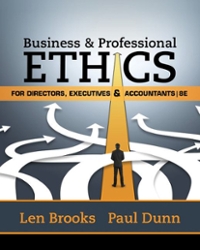Satyam Computer Services Ltd was founded in 1987 by B. Ramalinga Raju. By 2009, it was Indias
Question:
Satyam Computer Services Ltd was founded in 1987 by B. Ramalinga Raju. By 2009, it was India’s fourth-largest information technology company with 53,000 employees, operating in sixty-six countries. It provided a variety of services, including computer systems, customer services, and the outsourcing of accounting and finance. It had 185 of the Fortune 500 as customers and acted as a back office to such companies as Nestlé, General Motors, and General Electric.
On January 7, 2009, Raju sent a letter of resignation to the Board of Directors and to SEBI (the Securities and Exchange Board of India). In his letter, he outlined how he systematically falsified Satyam’s financial reports. The following was found respect to the September 2008 quarterly financial statements:
• The reported cash and bank balance of 5.36 billion rupees was overstated by 5.04 billion rupees (approximately \($1\) billion).
• The accrued interest of 376 million rupees was fictitious.
• There was an unrecorded liability of 1.2 billion rupees that Raju had with the company. • The quarterly revenue of 2.7 billion rupee was overstated by 22%, and the operating margin of 649 million rupees was overstated by 91%.
He revealed in his letter that what started as small discrepancies grew and, over time, reached unimaginable proportions.
“It was like riding a tiger, not knowing how to get off without being eaten.” He said that he alone had perpetrated the fraud and that no one on the Board of Directors knew about it. Raju concluded his letter by apologizing for what he had done and announced that he was prepared to accept the legal consequences of his actions.
In his resignation letter, Raju said that neither he nor any of his family had profited personally from the scam; none had sold their shares or taken any money out of the company. However, it was later revealed that 13,000 of the 53,000 Satyam employees were fictitious and that Raju was siphoning off approximately \($4\) million monthly from the company. Furthermore, it is alleged that Raju improperly transferred large numbers of Satyam shares to his mother and younger brother.
After the announcement of Raju’s resignation and the details of the fraud, the price of Satyam’s stock fell 78%, bringing down the Bombay stock exchange, the Sensex index, by 7.3%. In April 2010, the company was sold to Tech Mahindra and renamed Mahindra Satyam.
There had been signs of problems at Satyam’s prior to Raju’s resignation. In October 2008, the World Bank said that it was refusing to conduct any further business with Satyam after a Satyam employee had hacked into the World Bank’s computer system.
In the fall of 2008, Raju was concerned that his company was being targeted for a takeover, in which case the fraud would be detected. So, on December 16, he announced that Satyam would spend \($1.6\) billion to buy two construction companies, Maytas Property and Maytas Infra, each of which was run by two of his sons. (“Maytas” is “Satyam”
spelled backward.) His intention was to replace the fictitious assets with real ones.
However, his offer was quickly retracted under shareholder pressure. The next day, in New York, the price of Satyam’s ADRs lost 50% of their value. Also, in December, Forrester Research warned customers about continuing to do business with Satyam. The day before Raju’s resignation, DSP Merrill Lynch, which had been hired to consider strategic operations for the company, suddenly resigned after it learned about “material accounting irregularities.”
Following the collapse of the company, people began to ask questions about the role of Satyam’s auditor, Price Waterhouse
(PW), the Indian branch of Pricewaterhouse-
Coopers (PwC). People were wondering how PW could not detect, for example, that cash was overstated by 94%. The Indian exchange commission, SEBI, began an investigation into PW; PW had provided Satyam with clean audit opinions. The accusation is that by certifying the false financial statements as true, Price Waterhouse had misled investors.
The investigation by SEBI has not yet concluded, nor has there been a court case on the Satyam Computer Services Ltd fraud.
Questions:-
1. Will the Satyam fraud damage India’s reputation as a reliable provider of information technology outsourcing?
2. How long will it take to restore Satyam Computer’s reputation, and how would you recommend that the restoration be facilitated?
3. Raju did not commit this fraud on his own. What types of individuals probably assisted him either actively or by keeping quiet aboutwhat theyknewhewasdoing?
4. To whom should potential whistleblowers have complained?
5. Raju likened his fraud experience to “riding a tiger, not knowing how to get off without being eaten.” This is an aspect experienced by some people trapped on a slippery slope from small to ever-larger fraudulent acts. If Raju had come to you for advice during the tiger ride, what would you have advised him?
6. Should PwC worldwide have to pay any investors for their losses caused by faulty audit work of personnel in PWIndia?
Step by Step Answer:

Business And Professional Ethics
ISBN: 9781337514460
8th Edition
Authors: Leonard J Brooks, Paul Dunn





